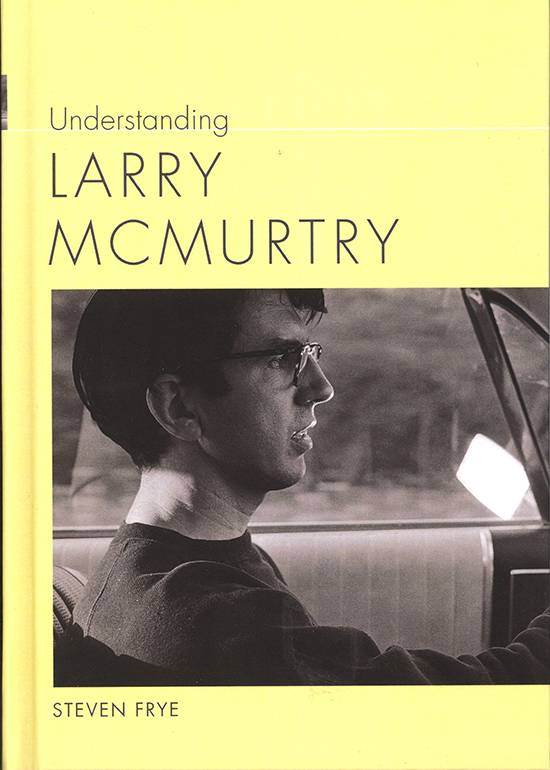We Don't Rent Pigs

Understanding Larry McMurtry
By Steven Frye
Columbia: University of South Carolina Press, 2017.
144 pp. $39.99 cloth.
Reviewed by
Mark Busby
Steven Frye undertakes either an ambitious project or a fool’s errand in his brief survey of the life and work of arguably Texas’s best known writer. To do justice to Larry McMurtry’s forty-five plus novels, memoirs, and nonfiction works in 119 pages of prose is a daunting task. Despite the Understanding Contemporary American Literature series format that generally includes a thorough overview of a writer’s work, Frye chooses simply to leave out many McMurtry books. Among the unmentioned (and probably unmentionable) are Boone’s Lick, Loop Group, Telegraph Days, The Last Kind Words Saloon, When the Light Goes, Rhino Ranch, Custer, and Crazy Horse. But he also provides no commentary on McMurtry’s three late memoirs—Books, Literary Life, and Hollywood—that offer great insight into McMurtry’s life and work. It would help if Frye explained his criteria for the works he included or ignored; to understand McMurtry as a writer requires knowing about his failures and weaknesses as well.
To survey the field, Frye follows the same general approach as other books that attempt to cover McMurtry’s huge output: he organizes his sections into recognizable groups including chapters on “The Early Works” [Horseman, Pass By and Leaving Cheyenne], “The Thalia Novels,” “The Houston Trilogy,” and “The Lonesome Dove Saga.” He concludes with a smorgasbord chapter titled “Other Works” in which he discusses Anything for Billy and Buffalo Girls and then quickly mentions the Berrybender novels, four-and-a-half pages on McMurtry’s nonfiction books such as In a Narrow Grave, and finally a couple of pages on the two collaborative novels with Diana Ossana. Frye does an efficient job summarizing the works he chooses to include. He is a perceptive critic who writes well.
Frye has a significant publication record on the American West having done Understanding Cormac McCarthy in the same Understanding Contemporary American Literature series. He has also edited The Cambridge Companion of the Literature of the American West and The Cambridge Companion to Cormac McCarthy. Here he rightly points to how McMurtry examines the mythic and antimythic dichotomy that energizes McMurtry’s frontier works that weave his ambivalent attraction and repulsion to America’s frontier past into his best works, especially Lonesome Dove. But Frye is at his best and most enlightening when he steps back and offers generalizing comments on what he thinks is the substance and significance of McMurtry’s work. Frye draws from his earlier scholarship on nineteenth century writers in Historiography and Narrative Design in the American Romance to identify what explains McMurtry’s appeal to both popular and literary audiences. Frye believes that McMurtry “employs and reconceptualizes the historical romance” and the novel of manners, both of which focus on “people in society” who function as complex psychological creatures whose world is defined by “recognizable conventions of behavior, manners, mores, and even preconceived social values.”
These works have a clear historical setting and are “always located in time and place” and echo “character and character relations.” Frye asserts that McMurtry’s particular contribution is his willingness to sacrifice virtually anything to the portrayal of character within a dense social context, even relinquishing quite often tightly structured plots. For McMurtry, the proper portrayal of characters and social realism involves the same lack of resolution and order that life itself involves.
Frye notes that the traditional novel of manners and the historical romance usually sidestep issues of modernity. McMurtry similarly has avoided “the narrative experimentation and complex narrative strategies” that characterize modernist literature, and he also avoids “philosophical and metaphysical questions.” Still, Frye finds “a thematic modernism clearly present in his work—the emphasis on radical social change, transience, psychological instability.”
Frye believes that what distinguishes McMurtry from his contemporaries is an ability to create novels about urban and rural life that explore “the complementary dreams of people who live in both locales, charting with sympathy the natural tensions that exist as two contradictory modes of living, together with different material values,” unified by what Frye finds a compelling tone:
There is a quality of bittersweet tragedy that pervades all of his works, as characters struggle and frequently fail to adapt to the inherent transience that is characteristic of America in the twentieth and twenty-first centuries, a transience typical as well of all times and all histories, of the human experience writ large.
So I come away from this book with a mixed feeling. Frye is certainly equipped to have done a fully developed critical analysis of the complete scope of McMurtry’s life, work, and contributions to the American experience. Given the limitations of this series, this book does not achieve that goal, but it fulfills the general purpose as a brief introduction. Perhaps Frye will expand his observations and insight—as well as his criticism of those McMurtry works about which he is silent here.
Mark Busby’s latest work is Through Our Times: Occasional Poems 1960-2017.
